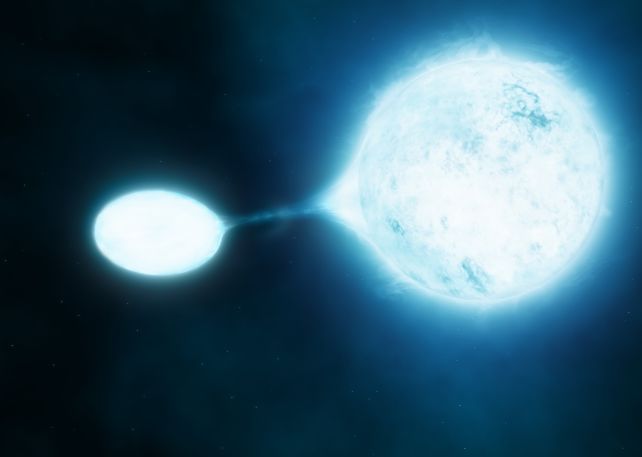Vampires may be lurking in space in the most ironic way possible – by hiding evidence of their kills in broad daylight.
What's more, just as Dracula had a diabolical assistant, these life-draining stars might be getting a little help from another nearby object.
A study of some of the brightest, hottest stars in the Milky Way suggests theorized binary systems comprizing of a rapidly-spinning star feeding off a companion might actually be trinary systems, with a drained husk of one star lurking in the larger star's glow and a second companion lurking nearby.
The new discovery suggests that such triple-star systems could be far more common than we thought.
'Stellar vampires' – better known as Be stars – are a type of B-type star, which are very hot, and very bright, and very blue, burning at temperatures up to 30,000 Kelvin. What distinguishes a Be star is rapid rotation and the presence of something known as Balmer emission; wavelengths of light emitted by hydrogen atoms.
This is thought to come from a disk of material that swirls around the star, which may come from the star itself losing mass into a disk around itself as it spins.

Another possible explanation is stellar vampirism. With a close enough companion, a more massive star can gravitationally strip that companion of material, which forms a disk that feeds into the larger star. The growth in mass increases the spin rate of the larger star.
All of this is neatly consistent with Be stars, with one problem: where are the close companions?
Led by astronomer Jonathan Dodd of the University of Leeds in the UK, astronomers decided to track the motion of the stars across the sky with high precision over time, a technique known as astrometry. This, they say, could reveal the presence of companion stars.
"We observed the way the stars move across the night sky, over longer periods like 10 years, and shorter periods of around six months. If a star moves in a straight line, we know there's just one star, but if there is more than one, we will see a slight wobble or, in the best case, a spiral," Dodd explains.
"We applied this across the two groups of stars that we are looking at – the B stars and the Be stars – and what we found, confusingly, is that at first it looks like the Be stars have a lower rate of companions than the B stars. This is interesting because we'd expect them to have a higher rate."
So the team looked at a different set of data – companion stars on a wider separation. And they found that the rate at which B and Be stars have companions at greater orbital distances is roughly the same.
This suggests that the gravitational interaction between three stars may push one of the stars closer to the Be star, close enough to be unceremoniously slurped.

The team concluded that the "missing" companions might not actually be missing, at all. If they've been vamped by the larger companions, they could be too small, low-mass, and faint to detect – especially if, as a consequence of a decaying orbit, they've spiraled in close to the larger Be star.
Trying to find one might be like looking for the glow of a single, small LED sitting right next to a searchlight from very far away.
The results have interesting implications for our understanding of the formation, growth, and evolution of stars in our galaxy, as well as their deaths. Systems like this could be the precursors to neutron stars and black holes, gaining enough mass during their hydrogen-burning lifetime for a core that collapses into these extremely dense, massive objects.
"Over the last decade or so, astronomers have found that binarity is an incredibly important element in stellar evolution. We are now moving more towards the idea it is even more complex than that and that triple stars need to be considered," says astrophysicist René Oudmaijer of the University of Leeds.
"Indeed, triples have become the new binaries".
The research has been published in the Monthly Notices of the Royal Astronomical Society.
